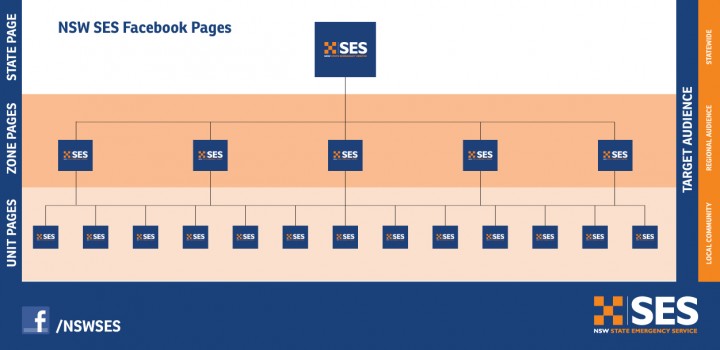Introduction
Why does NSW SES use social media?
NSW State Emergency Service has a legislative requirement to warn the communities of NSW before, during and after flood, storm and tsunami emergencies.
One of the ways we can do this is with the assistance of our various NSW SES Social Media channels.
Creating a NSW SES Page means you are creating a government social media channel.
This Page is NOT your Page but that of the NSW government. And with great power comes great responsibility.
Role of a Social Media Officer
If you choose to help out your Zone or Unit posting public information via social media on behalf of the service, there are a few things you should be aware of.
The role of social media in NSW SES and the expectations
NSW SES understands that volunteers like to interact and build trust within the local communities they protect. This is why many Units have set up social media channels to connect with the community and build a strong relationship promoting resilience. It is this reason that all NSW SES online channels are branded correctly and have the right logos and 132 500 messaging. All branding requirements, resources and campaigns can be found here on Brand Online.
As an community engagement tool
Once you Unit has established a social channel, your main focus would be to create content for the local community your Unit covers. Take the time to understand your audience, consider the purpose of your post and the times they are more active using Facebook Insights. Consider crafting some posts that take into consideration language barriers, minority groups and diverse cultural backgrounds etc based on your targeted area.
The variety of information you should post:
- Key messaging and preparedness information. See Storm, Flood and Tsunami web pages for content.
- Local NSW SES jobs and activity
- Statewide campaigns such as WOW Day and Get Ready
- Videos and high quality pictures
- Local achievements
- Member profiles
- Community Events and NSW SES participation
- Brand Awareness
- Recruitment opportunities
In an Operational Public Information capacity
The variety of information you should post:
- Key messaging and preparedness information
- NSW SES Warning and Evacuation information
- Flood guides and factsheets
- Local NSW SES job updates
- Videos and high quality pictures
- Recovery information
- BoM notifications and weather information
- Unit/Region/State statistics
Warning posts
- Post BOM or SES notifications
- Post key messages ie. Never enter floodwater
- Post critical contact numbers like 132 500 and triple zero 000
- What should your audience do now that they have received this information?
- Do we need to include a call to action? Do they need to read more about the warning?
- Send them to either the BoM website or NSW SES website to find out more.
Recovery posts
- Post important numbers
- Post council and public health information
- Post local land and environment information
- Post an update on what your Unit or team is still doing to help.
- Post preparedness information relevant to the event that just happened.
- Make sure posts are sensitive during times of emergencies or trauma, ie. #floodwit will not work after devastating circumstances.
- Post links to the NSW SES Recovery Guide
- You can shareLegal Help for Victims of Natural Disaster Video
- Share relevant and important information posted from the NSW Disaster Recovery
Social Media Policy breakdown
If you create a social media channel on behalf of the Service, you should:
- Include a both a zone representative and the web and social media coordinator as an admin on your account. This is to ensure if no one is able to post on your channel or are away on leave. Not to take over the account!
- Make sure the channel is branded correctly and does not bring the Service into disrepute.
- That no confidential information is published to the public domain.
- Not engage in bulling or trolling online.
- Not post information that is your personal opinion or show bias in any way.
- Blurry photos or photos with low light
- Videos that are too long and have no sound.
- Offensive content and sexual innuendos
- Information not related to the NSW SES and its support roles
- Fundraising and donation requests
- Internal content targeted to other members of the service
- Photos with incorrect PPE
- Relevant memes and photos
- Posting short relevant videos
- Including a call to action and sending the user back to the website for further information
- Images of pets and animals
- Puns and funny jokes
- Relevant hashtags
- Include a link to drive traffic to more information

Online Strategy for State Headquarters, Zone and Unit channels

